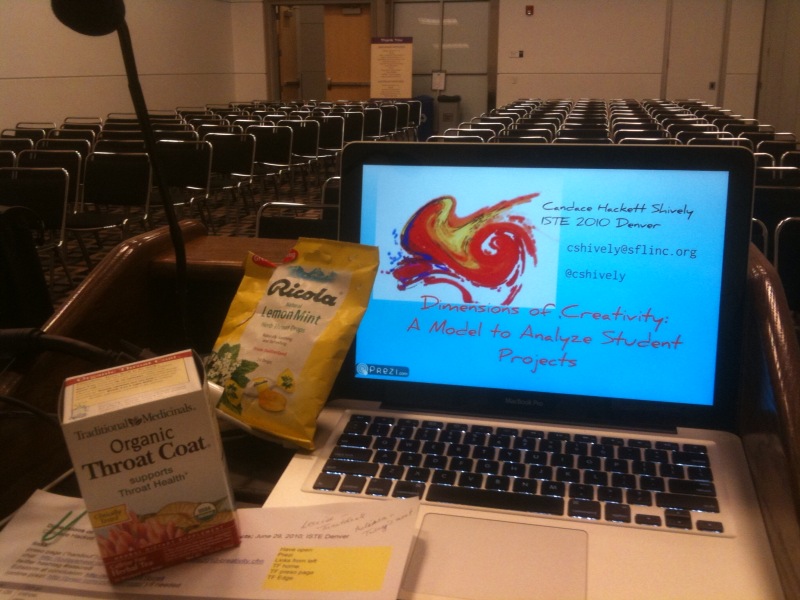New voices
 My creativity presentation at ISTE 2010 was surprising in unexpected ways. After months of anticipation and 30 hours of speechlessness –trying to regain a laryngitis-starved voice — I DID it, croaking into the most powerful mike the techies could find.
My creativity presentation at ISTE 2010 was surprising in unexpected ways. After months of anticipation and 30 hours of speechlessness –trying to regain a laryngitis-starved voice — I DID it, croaking into the most powerful mike the techies could find.
The gist of the presentation: using Guilford’s oldie-but-goodie model of creativity as four components (FFOE): Fluency, Flexibility, Originality, Elaboration, as a lens to analyze the tasks we assign and the projects students complete. What I enjoyed most were the conversations I had after the session was over.
One teacher talked of his concern that the hindrances to creativity in schools are followed by societal pressures in general as kids move up through high school. As kids assimilate into young adulthood, they have even greater barriers to risk-taking in their thinking. He feared that they might even use creative opportunities to reinforce some of those barriers. A valid concern. Together he and I ventured the possibility of challenging HS kids with this very question: what prevents you from sharing your off-the-wall ideas aloud? What can we do to take down those barriers?
The middle school teacher who cleverly tossed in a divergent response during the presentation stopped me in the hallway to say he planned to use the FFOE terms in rubrics and was excited to have a creativity vocabulary to use. We talked a bit about middle school as a great place to talk about creative self awareness while kids are becoming so aware of their bodies, individuality, and relationships with others.
A HS English teacher wondered aloud how to individualize creativity elements in rubrics for 150+ kids in a standards-based classroom. We hypothesized trying 4-5 rubric elements for everyone with an additional 2-3 agreed upon with individual students for each marking period. The elements do not even have to have “points” associated with them necessarily. He could discuss them as importnat for real life instead of grades. (Too bad that grades don’t relate to real life, though!)
During the waning hours of the conference, another middle school person stopped to talk with me at the SFL booth. We brainstormed a bit on what the rubric elements for FFOE might look like. As we talked, ideas began to pop up between us:
- What if you had kids form project groups by FFOE strength? One each string at fuency, flexibility, originality, elaboration? Would you find even numbers of each in a class? Probably not, but it would be an interesting experiment.
- Have kids contribute copies of brainstorms they did in their own best creative place/circumstance and hang them a bulletin board to celebrate individual creative process. The actual brainstorm materials or decorations should signal their best creative circumstance: a brainstorm on a scrap of towel or shampoo bottle for shower-thinkers, notes atop music or a CD wrapper for those who find music a creative lubricant, etc. Maybe a brainstorm written on a leaves from your “thinking tree”? We really liked that idea and agreed to stay in touch as she tries including FFOE in her teaching.
Many teachers, many thoughtful reactions. I cannot even relate all the discussions here. All from one hour together while my audience’s creative energy seemed to will my voice back from a painful, empty croak to fully voiced vibration. There was an audible gasp when one word suddenly came out with VOICE behind it, then another … and another. That VOICE is what every classroom community should help every learner feel: the experience of a newfound voice that emerges amid a surprising, vibrating rush.




[…] Think Like a Teacher » New voices blog.teachersfirst.com/thinkteach/2010/07/02/new-voices/ – view page – cached Filed under: about me, creativity, education, iste2010 — Candace Hackett Shively @ 10:40 am Tweets about this link […]
Pingback by Twitter Trackbacks for Think Like a Teacher » New voices [teachersfirst.com] on Topsy.com — July 2, 2010 @ 11:04 am
[…] ISTE I presented on Dimensions of Creativity, using Guilford’s classic (and OLD) model of divergent thinking […]
Pingback by Think Like a Teacher » Teaching and Creativity, Part 1: Talk about it — July 30, 2010 @ 10:20 am
[…] anything they could to help promote healing of my voice. You can read more about the experience in my post. The bottom line: my “voice” came through in far more ways than simply from that […]
Pingback by Think Like a Teacher » Most memorable things learned in 2010 — December 31, 2010 @ 2:10 pm